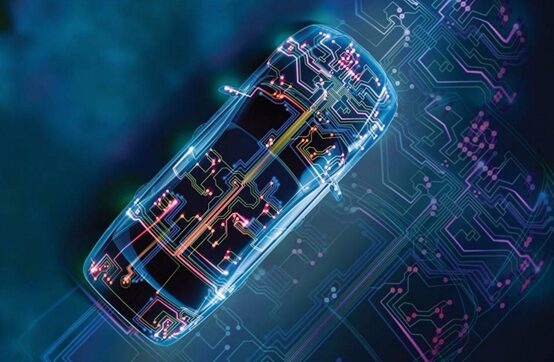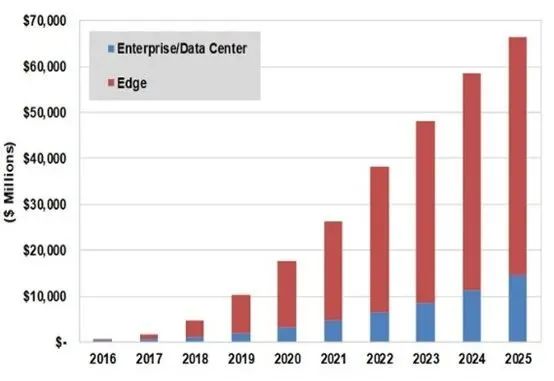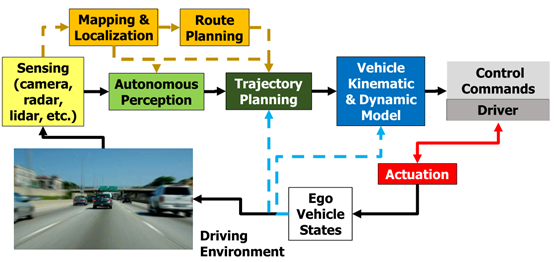Autonomous driving is an important application of edge computing, requiring 100-1000 TOPS of Edge AI computing power, which has become an industry barrier due to its high performance and low power consumption.

AI computing requires domains to optimize algorithms and data flow architectures. The Moore’s Law is nearing its limits; without the correct algorithms and architectures, performance driven solely by processing technology will not achieve the expected results.

The overall edge computing market is growing rapidly. Image source: IDC
Category One: Von Neumann AI Architecture
-
Harvard University has launched a parameterized deep learning benchmark suite ParaDNN, a systematic, scientific cross-platform benchmarking tool that not only compares the performance of various platforms running different deep learning models but also supports in-depth analysis of cross-model interactions, hardware design, and software support.
-
TPU (Tensor Processing Unit) is a processor built by Google specifically for machine learning, requiring fewer transistors for each operation, thus being more efficient. TPU is highly optimized for large batches of data for CNNs and DNNs, achieving the highest training throughput.
-
GPUs exhibit performance similar to TPUs but offer better flexibility and programmability for irregular computations (such as small batches and non-MatMul computations).
-
CPUs achieve the highest FLOPS utilization for RNNs and support the largest models due to their large memory capacity.

Category Two: Non-Von Neumann AI Architecture
-
Compute-in-Memory (CIM): CIM arrays based on SRAM, NAND flash, and emerging memories (like ReRAM, CeRAM, MRAM) are regarded as reconfigurable, reprogrammable accelerators for neural network computing. Advantages of CIM: high performance, high density, low power consumption, and low latency. Current challenges: reading bit line analog signal sensing and dedicated RAM processing technology’s ADC.
-
Neuromorphic computing extends AI to areas corresponding to human cognition, such as interpretation and autonomous adaptation. Next-generation AI must be able to handle new situations and abstractions to automate ordinary human activities.
-
Quantum computing: In quantum computing, the smallest unit of data is a qubit based on magnetic field spin. Quantum computing allows for more than two states based on quantum entanglement, with entanglement speeds being extremely fast (e.g., Google Sycamore, Quantum Supremacy, 53 qubits, 15 trillion times faster, completing a task in 200 seconds that would take a classical computer 10,000 years). Current challenges: error rates and decoherence in noisy intermediate-scale quantum (NISQ) computers.
-
Quantum neuromorphic computing physically implements neural networks in brain-like quantum hardware to accelerate computation speed.

-
Edge AI will dominate future computing; AI is a technology that can achieve future levels and vertical applications.
-
Horizontal AI applications address broad issues across various industries (e.g., computer vision and speech recognition); vertical AI applications are highly optimized for specific industries (e.g., high-definition maps, autonomous driving positioning and navigation). -
With deep domain knowledge, efficient AI models and algorithms can increase computation speed by 10 to 100,000 times. This is the core and most important technology for future autonomous driving. -
All vertical application solutions require multi-level AI models for multitasking.

-
DNN is the foundation of AI, and today’s DNN uses a form of learning called backpropagation. Modern DNNs train slowly and are static after training, sometimes unable to adapt flexibly in real applications.
-
Transfer learning is a method of “recycling” previously developed DNNs as a starting point for DNN learning of a second task. With transfer learning, DNNs can train models using less data.
-
Continual (lifelong) learning refers to the ability to continuously learn by adapting to new knowledge while retaining previous learning experiences. For example, autonomous driving interacting with the environment must learn from its own experiences and be capable of gradually acquiring, fine-tuning, and transferring knowledge over time.
-
Reinforcement Continual Learning (RCL) seeks the optimal neural structure for each new task through carefully designed reinforcement learning strategies. The RCL approach not only performs well in preventing catastrophic forgetting but also adapts well to new tasks.

Autonomous Driving Systems (ADS) – Functional Block Diagram. Image source: ARM
Breakthroughs Needed for Autonomous Driving Technology:
-
Edge precise positioning and navigation – lightweight, fingerprint-based precise positioning and navigation.
-
Critical real-time response – 20-30 milliseconds, similar to the human brain.
-
Eliminate blind spots – V2X, V2I, DSRC, 5G.
-
Upgradable – low power consumption and low cost.

Image source: ARM
Autonomous driving requires processing vast amounts of data in high-definition maps, positioning, and environmental perception, with all data needing to be processed within critical milliseconds. Smartly reducing data in perception, positioning, navigation, and enhanced interaction (driving strategy) will shorten latency in autonomous driving systems and enable quick responses to changing traffic conditions.
Powerful, high-performance Edge AI is one of the main barriers in the field of autonomous vehicles. 5G connectivity supports reliable MIMO connections, low latency, and high bandwidth. With the support of 5G, powerful Edge AI, combined with innovations in high-definition maps, positioning, and perception, will make true autonomous driving a reality.

-
Urban racing changes the track, smart cities become the main focus.
-
Seize the opportunity! Over 70 investments in 6 years, reviewing the autonomous driving layouts behind the five major internet giants.
-
2021 Automotive Environmental Perception and Sensor Technology Online Communication Forum successfully concluded.
-
Why are deterministic network security technologies so important for intelligent connected vehicles?
-
Growth-oriented vehicles | Policies usher in new regulations, OTA achieves major upgrades.
-
One article to introduce in-vehicle Ethernet, don’t miss it!
-
In the future, airless tires will become a popular trend in material selection for autonomous vehicles.
-
Autonomous driving industry weekly report (9.13).
-
The “Capital Science and Technology Innovation Achievement Exhibition – Smart Travel for Thousands of Miles” theme exhibition opens today.
-
Commercial vehicles vs. passenger vehicles, which is the “Canaan Land” of intelligent driving?
